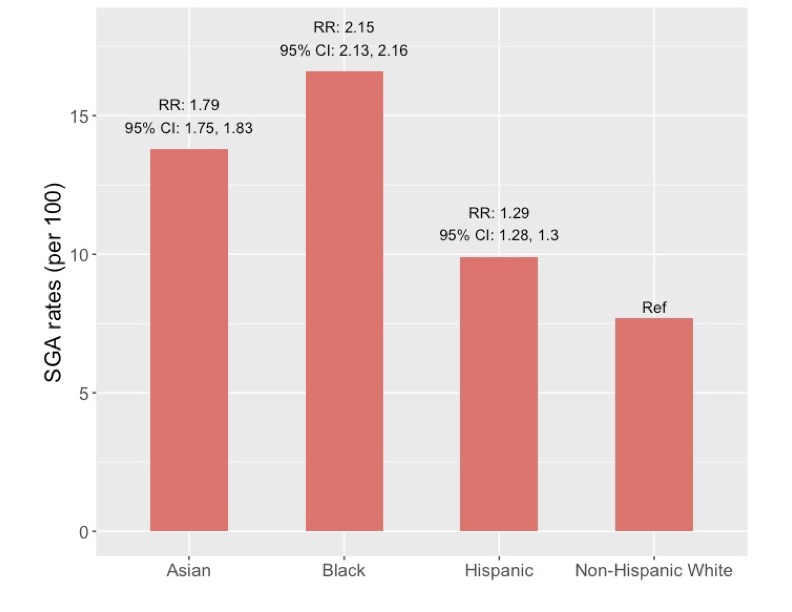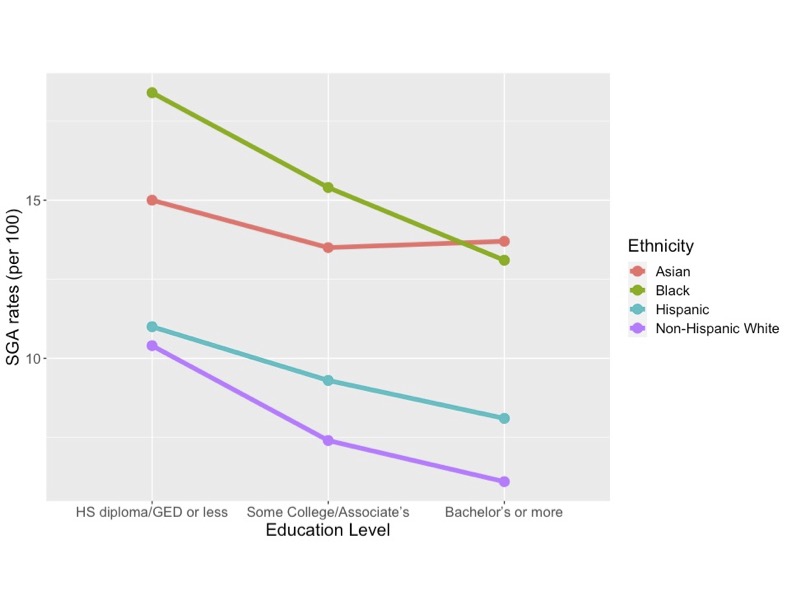Neonatology
Session: Neo-Perinatal Health Care Delivery 2: Epidemiology/Health Services Research
337 - The education-related patterns of small for gestational age among US-born women: the effect of race/ethnicity
Saturday, May 4, 2024
3:30 PM - 6:00 PM ET
Poster Number: 337
Publication Number: 337.1204
Publication Number: 337.1204

Kelli N. Hatter, MD (she/her/hers)
Resident Physician
Ann & Robert H. Lurie Children's Hospital of Chicago
Chicago, Illinois, United States
Presenting Author(s)
Background: Small for gestational age (weight for gestational age < 10th percentile, SGA) is a strong determinant of infant mortality and morbidity. African-American (AA) women have a greater SGA birth frequency than non-Latina (NL) White women. Few published studies have examined the SGA birth frequency of Latina and Asian women. The relationship between education attainment and race/ethnic-group specific SGA birth frequencies is unknown.
Objective: To determine the extent to which education attainment is associated with race/ethnic-group specific SGA birth frequencies among US-born women.
Design/Methods: We performed stratified and multivariable log binomial regression analyses on the 2018-2019 national vital records of singleton births to US-born AA (N= 866,253), NL-White (N= 3,386,855) Latina (N= 682,289), and Asian (N= 58,474) women. Selected co-variates included maternal age, education, marital status, parity, prenatal care usage, cigarette smoking, insurance status, and paternal acknowledgement.
Results: The RR of delivering an SGA infant approximated two for AA and Asian (compared to NL-White) women (Figure 1). The percentage with a bachelor’s degree or higher ranged from 15% for AA, 16% for Latina, and 42% for NL-White women to 65% for Asian women. With the exception of Asian women, race/ethnic group-specific SGA birth frequencies declined as maternal education attainment rose (Figure 2). In each race/ethnic group, the distribution of high-risk co-variates decreased as maternal education attainment increased (Table 2). The adjusted RR (95% CI) of delivering an SGA infant for AA, non-NL-White, and Latina women with a bachelor’s degree or higher (compared to those who failed to complete High School) equaled 0.8 (0.8, 0.8). In stark contrast, the adjusted RR (95% CI) of delivering an SGA infant for Asian women with a bachelor’s degree or higher (compared to those who failed to complete High School) equaled 1.0 (0.9, 1.0).
Conclusion(s): A similar strong protective association of rising education attainment and SGA birth frequency exists among US-born AA, NL-White, and Latina women. Interestingly, this phenomenon is absent among US-born Asian women. These intriguing findings have public health relevance to racial/ethnic group differences SGA birth frequencies.
.jpg)


